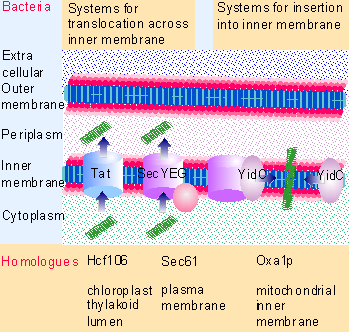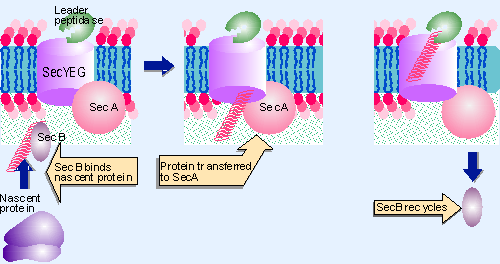11. Bacteria use both co-translational and post-translational translocation
8.11 Bacteria use both co-translational and post-translational translocation |
| Key terms defined in this section |
| Periplasm (or periplasmic space) is the region between the iner and outer membranes in the bacterial envelope. |
The bacterial envelope consists of two membrane layers. The space between them is called the periplasm. Proteins are exported from the cytoplasm to reside in the envelope or to be secreted from the cell. The mechanisms of secretion from bacteria are similar to those characterized for eukaryotic cells, and we can recognize some related components. Proteins that are exported from the cytoplasm have one of four fates:
- to be inserted into the inner membrane
- to be translocated through the inner membrane to rest in the periplasm
- to be inserted into the outer membrane
- to be translocated through the outer membrane into the medium.
Different protein complexes in the inner membrane are responsible for transport of proteins depending on whether their fate is to pass through or stay within the inner membrane. This resembles the situation in mitochondria, where different complexes in each of the inner and outer membranes handle different subsets of protein substrates depending on their destinations (see 8.5 Post-translational membrane insertion depends on leader sequences) A difference from import into organelles is that transfer in E. coli may be either co- or post-translational. Some proteins are secreted both co-translationally and post-translationally, and the relative kinetics of translation versus secretion through the membrane could determine the balance.
Exported bacterial proteins have N-terminal leader sequences, with a hydrophilic N-terminus and an adjacent hydrophobic core. The leader is cleaved by an enzyme called leader peptidase that recognizes precursor forms of several exported proteins. The leader peptidase is an integral membrane protein, located in the inner membrane. Mutations in N-terminal leaders prevent secretion; they are suppressed by mutations in other genes, which are thus defined as components of the protein export apparatus. Several genes given the general description sec are implicated in coding for components of the secretory apparatus by the occurrence of mutations that block secretion of many or all exported proteins.
 |
Figure 8.33 The Tat and SecYEG ystems are used for proteins that are translocated across the inner membrane. YidC may be used ith or without SecYEG to insert proteins into the inner membrane. |
Figure 8.33 summarizes systems that are involved in transport through the inner membrane. The best characterized system is the SecYEG translocon. Its subunits are related to the components of mammalian/yeast Sec61 (for review see Oliver, 1985; Lee and Beckwith, 1986). The subunits are integral transmembrane proteins. (SecY has 10 transmembrane segments and SecE has 3 transmembrane segments.) The functional translocon is a trimer with one copy of each subunit (Yahr and Wickner, 2000). The Tat system is named for its ability to transport proteins bearing a twin arginine targeting motif. It is related to a system in the chloroplast thylakoid luman called Hcf106 (for review see Dalbey and Robinson, 1999). Both of these systems transport proteins into the periplasm. The YidC protein is required to insert proteins into the inner membrane (Samuelson et al., 2000). It may function either independently of SecYEG or in conjunction with it. A homologous protein (Oxa1p) is required when proteins are inserted into the inner mitochondrial membrane from the matrix.
 |
Figure 8.34 SecB is a chaperone that transfers a nascent protein to SecA, which is a peripheral membrane protein associated with the integral membrane protein complex SecYEG. Translocation requires hydrolysis of ATP and a protonmotive force. Leader peptidase is an integral membrane protein that cleaves the leader sequence. |
A principal pathway for proteins that are secreted through SecYEG into the periplasm is summarized in Figure 8.34. A chaperone binds to the nascent protein to control its folding; the protein associates with the secretion apparatus; it is translocated through the membrane; and a peptidase cleaves the leader from proteins with a cleavable N-terminus.
Several chaperones can increase the efficiency of bacterial protein export by preventing premature folding; they include trigger factor (characterized as a chaperone that assists export), GroEL (see earlier), and SecB (identified as the product of one of the sec mutants). Although SecB is the least abundant of these proteins, it has the major role in promoting export. It has two functions. First, it behaves as a chaperone and binds to a nascent protein to retard folding. It cannot reverse the change in structure of a folded protein, so it does not function as an unfolding factor. Its role is therefore to inhibit improper folding of the newly synthesized protein. Second, it has an affinity for the protein SecA. This allows it to target a precursor protein to the membrane (Collier et al., 1988; Crooke et al., 1988). The SecB-SecYEG pathway is used for translocation ofproteins that are secreted into the periplasm.
SecA is a large peripheral membrane protein that has alternative ways to associate with the membrane. As a peripheral membrane protein, it associates with the membrane by virtue of its affinity for acidic lipids and for the SecY component of the translocon., which are part of a multisubunit complex that provides the translocase function. However, in the presence of other proteins (SecD and SecF), SecA can be found as a membrane-spanning protein. It probably provides the motor that pushes the substrate protein through the SecYEG translocon.
SecA recognizes both SecB and the precursor protein that it chaperones; probably features of the mature protein sequence as well as its leader are required for recognition. SecA has an ATPase activity that depends upon binding to lipids, SecY, and a precursor protein. The ATPase functions in a cyclical manner during translocation. After SecA binds a precursor protein, it binds ATP, and ~20 amino acids are translocated through the membrane. Hydrolysis of ATP is required to release the precursor from SecA. Then the cycle may be repeated. Precursor protein is bound again to provide the spur to bind more ATP, translocate another segment of protein, and release the precursor. SecA may alternate between the peripheral and integral membrane forms during translocation; with each cycle, a 30 kD domain of SecA may insert into the membrane and then retract (Brundage et al., 1990).
Another process can also undertake translocation. When a precursor is released by SecA, it can be driven through the membrane by a protonmotive force (that is, an electrical potential across the membrane). This process cannot initiate transfer through the membrane, but can continue the process initiated by a cycle of SecA ATPase action. So after or between cycles of the SecA-ATP driven reaction, the protonmotive force can drive translocation of the precursor.
The E. coli ribonucleoprotein complex of 4.5S RNA with Ffh and FtsY proteins is a counterpart to the SRP. It probably plays the role of keeping the nascent protein in an appropriate conformation until it interacts with other components of the secretory apparatus. It is needed for the secretion of some, but not all, proteins. Its substrates are integral membrane proteins, and it appears to provide an alternative route for directing them to SecYEG (Beck et al., 2000). The basis for differential selection of substrates is that the E. coli SRP recognizes an anchor sequence in the protein (anchor sequences by definition are present only in integral membrane proteins).
Mutations in the gene yidC block insertion of proteins into the inner membrane (Beck et al., 2000). The insertion of some of these proteins requires SecYEG, suggesting that YidC acts in conjunction with the translocon to divert the substrate into membrane insertion as opposed to secretion. Other proteins whose insertion depends on YidC do not require SecYEG: it seems likely that some other (unidentified) functions are required instead of the translocon.
The Tat system is responsible for translocation of proteins that have tightly bound cofactors. This may mean that they have limitations on their ability to unfold for passage through the membrane. This would be contrary to the principle of all other known translocation systems, where the protein passes through the membrane in an unfolded state, and then must be folded into its mature conformation after passage (for review see Dalbey and Robinson, 1999).
This section updated 8-22-2000
| Reviews | |
| Dalbey, R. E. and Robinson, C. (1999). Protein translocation into and across the bacterial plasma membrane and the plant thylakoid membrane. . Trends Biochem Sci. 24 , 17-22. | |
| Lee, C. and Beckwith, J. (1986). Cotranslational and posttranslational protein translocation in prokaryotic systems. Ann. Rev. Cell Biol. 2, 315-336. | |
| Oliver, D. (1985). Protein secretion in E. coli. Ann. Rev. Immunol. 39, 615-648. | |
| Research | |
| Beck, K. , Wu, L. F. , Brunner, J. , and Muller, M. (2000). Discrimination between SRP- and SecA/SecB-dependent substrates involves selective recognition of nascent chains by SRP and trigger factor. . EMBO J. 19, 134-143. | |
| Brundage, L. et al. (1990). The purified E. coli integral membrane protein SecY/E is sufficient for reconstitution of SecA-dependent precursor protein translocation. Cell 62, 649-657. | |
| Collier, D. N. et al. (1988). The antifolding activity of SecB promotes the export of the E. coli maltose-binding protein. Cell 53, 273-283. | |
| Crooke, E. et al. (1988). ProOmpA is stabilized for membrane translocation by either purified E. coli trigger factor or canine signal recognition particle. Cell 54, 1003-1011. | |
| Samuelson, J. C. , Chen, M. , Jiang, F. , Moller, I. , Wiedmann, M. , Kuhn, A. , Phillips, G. J. , and Dalbey, R. E. (2000). YidC mediates membrane protein insertion in bacteria . Nature 406, 637-641. | |
| Yahr, T. L. and Wickner, W. T. (2000). Evaluating the oligomeric state of SecYEG in preprotein translocase.. EMBO J. 19, 4393-4401. | |